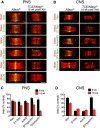Differential stability of PNS and CNS nodal complexes when neuronal neurofascin is lost
- PMID: 24719087
- PMCID: PMC3983793
- DOI: 10.1523/JNEUROSCI.4662-13.2014
Differential stability of PNS and CNS nodal complexes when neuronal neurofascin is lost
Abstract
Fast, saltatory conduction in myelinated nerves requires the clustering of voltage-gated sodium channels (Nav) at nodes of Ranvier in a nodal complex. The Neurofascin (Nfasc) gene encodes neuronal Neurofascin 186 (Nfasc186) at the node and glial Neurofascin 155 at the paranode, and these proteins play a key role in node assembly. However, their role in the maintenance and stability of the node is less well understood. Here we show that by inducible ablation of Nfasc in neurons in adult mice, Nfasc186 expression is reduced by >99% and 94% at PNS and CNS nodes, respectively. Gliomedin and NrCAM at PNS and brevican at CNS nodes are largely lost with neuronal neurofascin; however, Nav at nodes of Ranvier persist, albeit with ∼40% reduction in expression levels. βIV Spectrin, ankyrin G, and, to a lesser extent, the β1 subunit of the sodium channel, are less affected at the PNS node than in the CNS. Nevertheless, there is a 38% reduction in PNS conduction velocity. Loss of Nfasc186 provokes CNS paranodal disorganization, but this does not contribute to loss of Nav. These results show that Nav at PNS nodes are still maintained in a nodal complex when neuronal neurofascin is depleted, whereas the retention of nodal Nav in the CNS, despite more extensive dissolution of the complex, suggests a supportive role for the partially disrupted paranodal axoglial junction in selectively maintaining Nav at the CNS node.
Keywords: myelination; neurofascin; nodes of Ranvier; sodium channels.
Figures




Similar articles
-
Long-term maintenance of Na+ channels at nodes of Ranvier depends on glial contact mediated by gliomedin and NrCAM.J Neurosci. 2014 Apr 9;34(15):5089-98. doi: 10.1523/JNEUROSCI.4752-13.2014. J Neurosci. 2014. PMID: 24719088 Free PMC article.
-
Neurofascin 140 is an embryonic neuronal neurofascin isoform that promotes the assembly of the node of Ranvier.J Neurosci. 2015 Feb 4;35(5):2246-54. doi: 10.1523/JNEUROSCI.3552-14.2015. J Neurosci. 2015. PMID: 25653379 Free PMC article.
-
Glial and neuronal isoforms of Neurofascin have distinct roles in the assembly of nodes of Ranvier in the central nervous system.J Cell Biol. 2008 Jun 30;181(7):1169-77. doi: 10.1083/jcb.200712154. Epub 2008 Jun 23. J Cell Biol. 2008. PMID: 18573915 Free PMC article.
-
[New insights on the organization of the nodes of Ranvier].Rev Neurol (Paris). 2014 Dec;170(12):819-24. doi: 10.1016/j.neurol.2014.03.017. Epub 2014 Nov 20. Rev Neurol (Paris). 2014. PMID: 25459119 Review. French.
-
The Axonal Cytoskeleton and the Assembly of Nodes of Ranvier.Neuroscientist. 2018 Apr;24(2):104-110. doi: 10.1177/1073858417710897. Epub 2017 May 23. Neuroscientist. 2018. PMID: 28534438 Free PMC article. Review.
Cited by
-
The olfactomedin domain from gliomedin is a β-propeller with unique structural properties.J Biol Chem. 2015 Feb 6;290(6):3612-21. doi: 10.1074/jbc.M114.627547. Epub 2014 Dec 17. J Biol Chem. 2015. PMID: 25525261 Free PMC article.
-
The Nodes of Ranvier: Molecular Assembly and Maintenance.Cold Spring Harb Perspect Biol. 2015 Sep 9;8(3):a020495. doi: 10.1101/cshperspect.a020495. Cold Spring Harb Perspect Biol. 2015. PMID: 26354894 Free PMC article. Review.
-
Myelinated axon physiology and regulation of neural circuit function.Glia. 2019 Nov;67(11):2050-2062. doi: 10.1002/glia.23665. Epub 2019 Jun 24. Glia. 2019. PMID: 31233642 Free PMC article. Review.
-
Chronic peripheral nerve compression disrupts paranodal axoglial junctions.Muscle Nerve. 2017 Apr;55(4):544-554. doi: 10.1002/mus.25273. Epub 2016 Dec 26. Muscle Nerve. 2017. PMID: 27463510 Free PMC article.
-
Chondroitin Sulphate Proteoglycan Axonal Coats in the Human Mediodorsal Thalamic Nucleus.Front Integr Neurosci. 2022 Jul 6;16:934764. doi: 10.3389/fnint.2022.934764. eCollection 2022. Front Integr Neurosci. 2022. PMID: 35875507 Free PMC article.
References
-
- Bhat MA, Rios JC, Lu Y, Garcia-Fresco GP, Ching W, St Martin M, Li J, Einheber S, Chesler M, Rosenbluth J, Salzer JL, Bellen HJ. Axon-glia interactions and the domain organization of myelinated axons requires neurexin IV/Caspr/Paranodin. Neuron. 2001;30:369–383. doi: 10.1016/S0896-6273(01)00294-X. - DOI - PubMed
-
- Charles P, Tait S, Faivre-Sarrailh C, Barbin G, Gunn-Moore F, Denisenko-Nehrbass N, Guennoc AM, Girault JA, Brophy PJ, Lubetzki C. Neurofascin is a glial receptor for the paranodin/Caspr-contactin axonal complex at the axoglial junction. Curr Biol. 2002;12:217–220. doi: 10.1016/S0960-9822(01)00680-7. - DOI - PubMed
-
- Chen C, Westenbroek RE, Xu X, Edwards CA, Sorenson DR, Chen Y, McEwen DP, O'Malley HA, Bharucha V, Meadows LS, Knudsen GA, Vilaythong A, Noebels JL, Saunders TL, Scheuer T, Shrager P, Catterall WA, Isom LL. Mice lacking sodium channel beta1 subunits display defects in neuronal excitability, sodium channel expression, and nodal architecture. J Neurosci. 2004;24:4030–4042. doi: 10.1523/JNEUROSCI.4139-03.2004. - DOI - PMC - PubMed
Publication types
MeSH terms
Substances
Grants and funding
LinkOut - more resources
Full Text Sources
Other Literature Sources
Molecular Biology Databases
